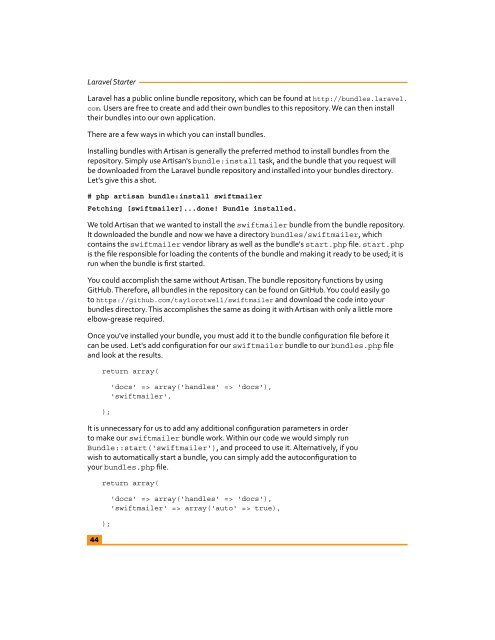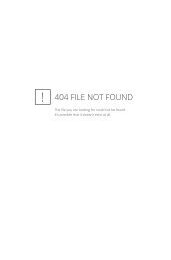Laravel Starter - PHP User Group (Myanmar)
Laravel Starter - PHP User Group (Myanmar)
Laravel Starter - PHP User Group (Myanmar)
You also want an ePaper? Increase the reach of your titles
YUMPU automatically turns print PDFs into web optimized ePapers that Google loves.
<strong>Laravel</strong> <strong>Starter</strong><br />
<strong>Laravel</strong> has a public online bundle repository, which can be found at http://bundles.laravel.<br />
com. <strong>User</strong>s are free to create and add their own bundles to this repository. We can then install<br />
their bundles into our own application.<br />
There are a few ways in which you can install bundles.<br />
Installing bundles with Artisan is generally the preferred method to install bundles from the<br />
repository. Simply use Artisan's bundle:install task, and the bundle that you request will<br />
be downloaded from the <strong>Laravel</strong> bundle repository and installed into your bundles directory.<br />
Let's give this a shot.<br />
# php artisan bundle:install swiftmailer<br />
Fetching [swiftmailer]...done! Bundle installed.<br />
We told Artisan that we wanted to install the swiftmailer bundle from the bundle repository.<br />
It downloaded the bundle and now we have a directory bundles/swiftmailer, which<br />
contains the swiftmailer vendor library as well as the bundle's start.php file. start.php<br />
is the file responsible for loading the contents of the bundle and making it ready to be used; it is<br />
run when the bundle is first started.<br />
You could accomplish the same without Artisan. The bundle repository functions by using<br />
GitHub. Therefore, all bundles in the repository can be found on GitHub. You could easily go<br />
to https://github.com/taylorotwell/swiftmailer and download the code into your<br />
bundles directory. This accomplishes the same as doing it with Artisan with only a little more<br />
elbow-grease required.<br />
Once you've installed your bundle, you must add it to the bundle configuration file before it<br />
can be used. Let's add configuration for our swiftmailer bundle to our bundles.php file<br />
and look at the results.<br />
44<br />
return array(<br />
);<br />
'docs' => array('handles' => 'docs'),<br />
'swiftmailer',<br />
It is unnecessary for us to add any additional configuration parameters in order<br />
to make our swiftmailer bundle work. Within our code we would simply run<br />
Bundle::start('swiftmailer'), and proceed to use it. Alternatively, if you<br />
wish to automatically start a bundle, you can simply add the autoconfiguration to<br />
your bundles.php file.<br />
return array(<br />
);<br />
'docs' => array('handles' => 'docs'),<br />
'swiftmailer' => array('auto' => true),




